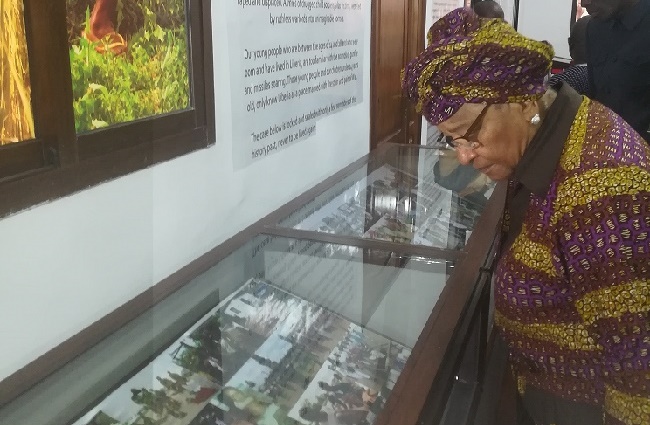Sirleaf: National memories must unify Liberians

President Sirleaf views some of the historical pictures in the museum
On the shoulders of the intersection of Broad and Buchanan Streets in Monrovia, the Liberian capital, sits a 174-year old building painted in dominant white with dotted brown curvy designs on every side. That’s the National Museum of Liberia- a historic and cultural asset that shriveled in ruins for many years.
The structure, representative of Liberia’s long and rich history, was dedicated by President Ellen Johnson-Sirleaf on November 29 in Monrovia.
Speaking at the ceremony, President Ellen Johnson-Sirleaf praised the curator, Carol Alexander, for the level of passion she showed in getting the museum opened again for public access.
“I can only hope that this structure, the memories that are placed here will serve as a unifying force; as a reconciling force that Liberians through the waves of their history will see that they are one and this structure will be merely ceremonial,” she said.
The Liberian leader stressed the need for every Liberian to protect this national asset, defend it, maintain it and enable it to grow because there is so much more that can be added to it.
Commenting earlier, Minister of Information Culture and Tourism, Eugene Lenn Nagbe lauded the professionalism and passion of Mrs. Alexander for overseeing the project and ensuring that the country can once again boast of a museum.
“Yes, it was Madam President’s dream. Yes, it was our fiduciary responsibility but without the drive and the passion and exuberance that Madam Alexander brought to the situation, I am not sure we would have been here today,” Minister Nagbe noted.
He added that the reopening of the museum means that Liberia can achieve anything with the right driver and nothing can be impossible to achieve.
Minister Nagbe averred that the building holding the museum is a history by itself because it predates Liberia’s declaration of independence.
“This building was commissioned in 1843. So, history starts from the door and then as you go in, the artifacts that have been catalogued from pre-independence up to where we are today,” he said.
Minister Nagbe disclosed that Liberia has reached another milestone by seeing two of its cultural and world historic assets: the Providence Island and the Nimba range placed on UNESCO tentative list of world heritage sites, indicating that the Island is not just a history site for Liberia but for the world.
He reminded the public that the dedication of the National Museum in Monrovia is just phase one of the project and phase two will include the expansion of other museums across the country, particularly in Maryland County.
For her part, Mrs. Alexander said she had the vision and passion to get museum back up but it took the cooperation of a team of Liberians who were willing to make their contribution to the national effort.
She said the museum is about exposure, re-teaching and re-educating and remembering.
“If I wanted this great nation to rise again, I had to become a Liberian by identity- the name Juah that was given to me because the workers said I behave like a “Kru woman,” Madam Carol intimated.
She stressed her desire to do everything to revitalize education and culture. The curator encouraged other people to teach their younger ones about the importance of culture at all times. “We have to make everyone in this nation feel a part of the country’s existence,” she emphasized.
Mrs. Alexander is the CEO of MaBu, a Cultural Resource Company. She was the founding director of the Ritz Theatre and Museum in Jacksonville, Florida (USA), the city’s 35,000 square foot museum and theater of African American history and culture. Her service was arranged through the former director of the Smithsonian African Art Museum.
The three floors of exhibitions collectively entitled Waves of Time explore the ebb and flow of Liberia’s history, cultures, peoples and artistic expressions.
The exhibitions inform and enlighten visitors through the use of rare and contemporary artifacts, documents, photographs, archival videos, art works, sculptures and installations of a traditional hut and a country kitchen.
Stories about and images of Liberia’s 16 ethnic groups as well as the establishment of Americo-Liberian communities are followed by the history of the Republic of Liberia and its quest for unity, peace and prosperity.
Finally, art works by talented, contemporary Liberian artists artistically interpret the country and its peoples’ past, present and future.
The museum was severely damaged during the civil war and many items and objects in its collections were damaged, destroyed or stolen.
Michael Roberts

